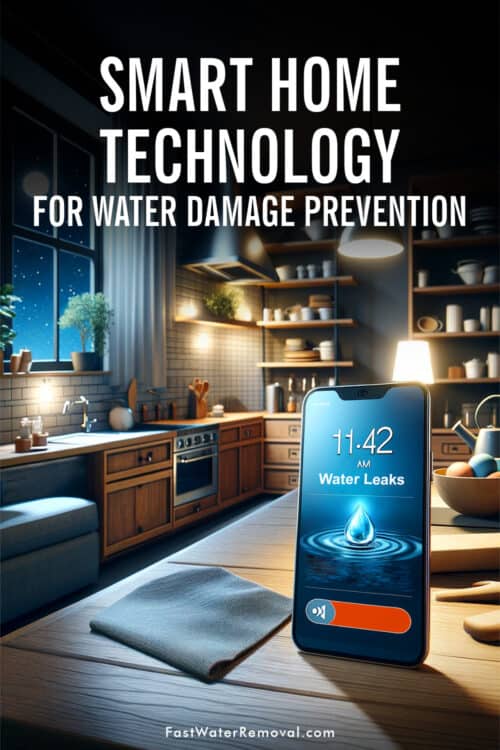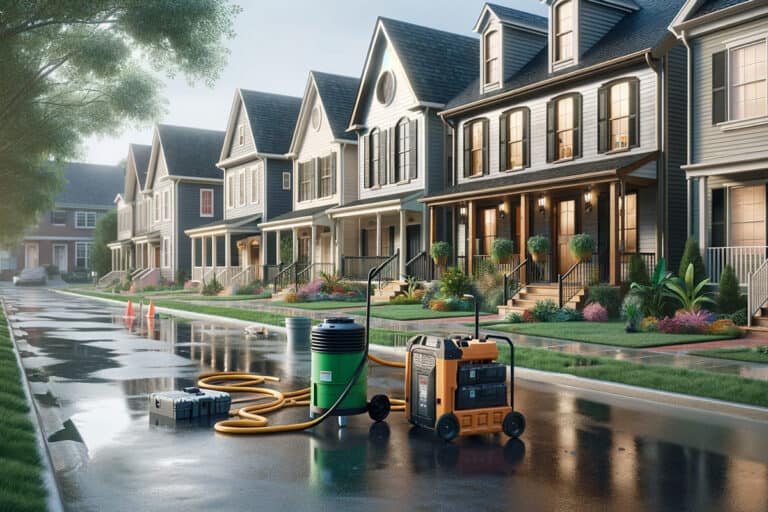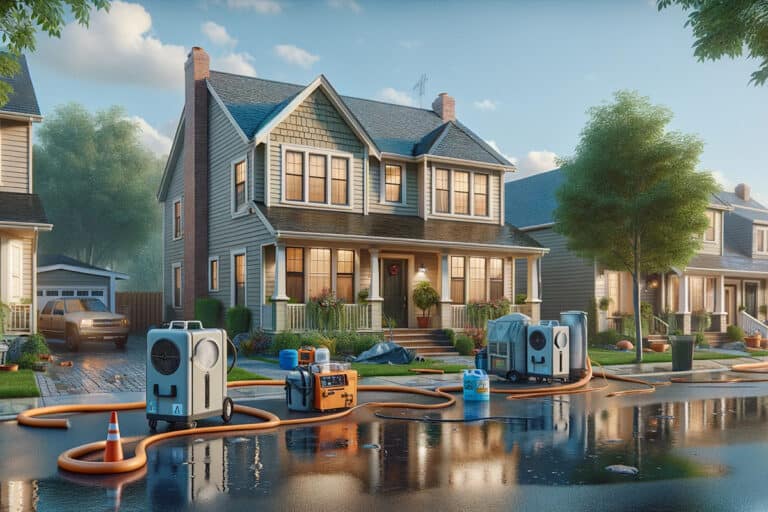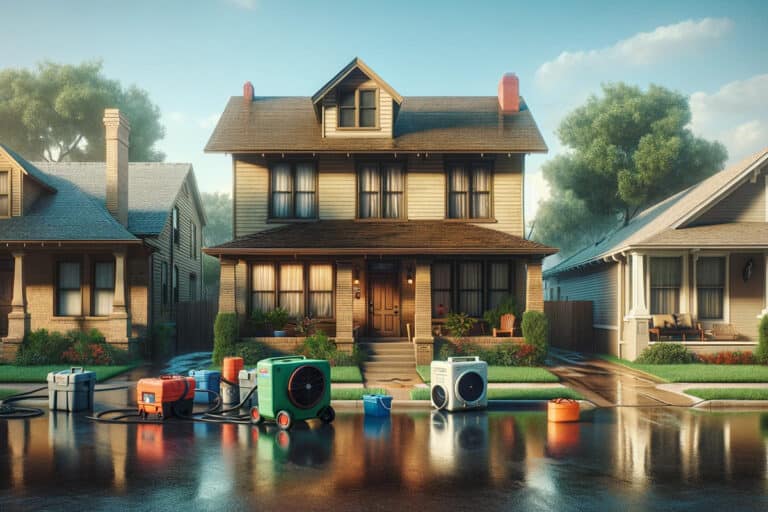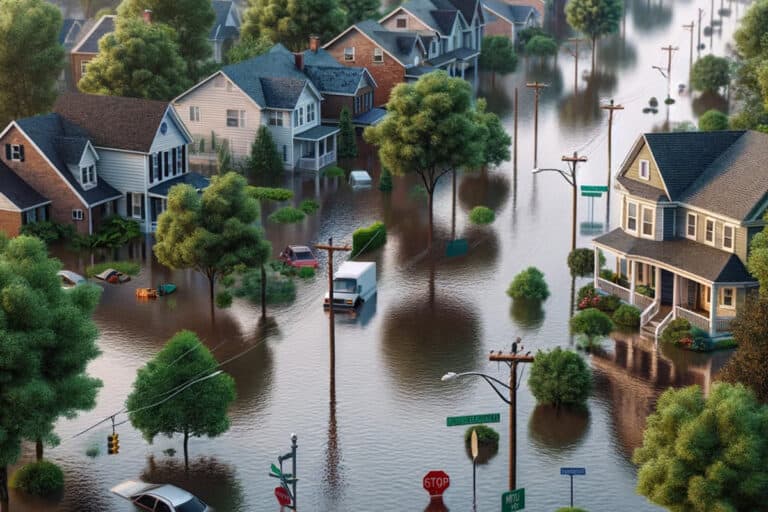Disclosure: I am compensated for purchases made through some links on this site. Click for details.
Water damage is among the most prevalent and costly problems faced by homeowners today. From ruining cherished belongings to causing structural damage that can cost thousands to repair, the implications of water intrusion are both financially and emotionally draining. However, in the digital age where technology touches nearly every aspect of our lives, smart home technology emerges as a beacon of hope. This comprehensive guide dives deep into how leveraging smart home technology and IoT (Internet of Things) solutions can revolutionize the way we detect and prevent water damage, safeguarding our homes and our peace of mind.
Imagine leaving for a vacation, only to return to a home soaked in water because of a burst pipe or a leaking appliance. Such scenarios are not just nightmares but realities for many. The advent of smart home technology, however, has introduced a new era of home management where prevention and early detection of water damage are not just possible but highly effective.
This article explores the innovative world of smart home devices designed to combat water damage. With advancements in IoT smart devices, homeowners now have the power to monitor their homes remotely, receiving alerts at the first sign of moisture or leaks. These technologies not only provide a substantial layer of protection but also offer peace of mind, knowing that your home is guarded against the threat of water damage 24/7.
Join us as we navigate through the best smart home technologies available for preventing household water damage, from WiFi water sensors to automatic shut-off valves, and how integrating these IoT solutions can keep your home dry and secure.
Water Damage Risks in Homes
Water damage is not just an inconvenience; it’s a prevalent issue that can wreak havoc on the structural integrity of homes, lead to the growth of harmful mold, and result in the loss of valuable personal property. Understanding the common causes and impacts of water damage is the first step toward prevention.
Common Causes of Water Damage
- Leaking Pipes: Often hidden within walls, leaks can go unnoticed until significant damage has occurred.
- Appliance Failures: Dishwashers, washing machines, and water heaters are common culprits of water leaks.
- Natural Disasters: Floods, hurricanes, and heavy rains can overwhelm home defenses.
- Poor Drainage: Blocked gutters and downspouts can lead to water seepage into basements and crawl spaces.
Impacts of Water Damage
- Financial Cost: The expense of repairs and replacements can quickly add up, not to mention potential increases in insurance premiums.
- Health Risks: Damp environments are breeding grounds for mold and mildew, posing serious health risks.
- Emotional Stress: The disruption and loss caused by water damage can have a significant emotional toll on homeowners.
Understanding these risks underscores the importance of adopting proactive measures. Smart home technology offers an effective solution by providing early detection and prevention capabilities, minimizing the potential for damage.
By leveraging smart home devices, homeowners can significantly mitigate these risks. These technologies not only alert homeowners to the first signs of moisture but also offer the means to take immediate action, potentially saving thousands in repairs and invaluable peace of mind.
In the following sections, we’ll explore the smart home technologies available to combat these challenges, detailing how each can play a pivotal role in water damage prevention.
Smart Home Technology: A Beacon of Prevention
In the face of the ever-present threat of water damage, smart home technology shines as a proactive defender. Equipped with advanced sensors and IoT capabilities, these devices empower homeowners to detect and address leaks and moisture before they escalate into costly disasters. Let’s delve into how these innovative solutions can fortify your home against water damage.
Smart Water Sensors: Your First Line of Defense
Smart water sensors are the vanguard in the battle against water damage, offering real-time alerts to the presence of moisture where it shouldn’t be. These compact, yet powerful devices can be placed in high-risk areas such as under sinks, near water heaters, and beside washing machines, providing instant notifications to your smartphone at the first sign of a leak.
Top Picks:
- Flo by Moen: Renowned for its sensitivity and reliability, it can detect even the smallest drips.
- Honeywell Home Water Leak Detector: Offers easy installation and integrates seamlessly with wider smart home systems.
Key Benefits:
- Immediate Alerts: Receive notifications directly to your phone, enabling swift action.
- Easy Installation: Most sensors are designed for DIY setup, requiring no special tools or expertise.
- Peace of Mind: Knowing that you’re continuously monitored provides immense relief.
Automatic Shut-Off Valves: Halting Water Damage in Its Tracks
For an added layer of protection, automatic shut-off valves are indispensable. These devices take action when a leak is detected, automatically cutting off the water supply to prevent further damage. They are particularly valuable in mitigating the risk of catastrophic leaks when the home is unattended.
Highlighted Devices:
- Grohe Sense Guard: Installs on your main water line and shuts off water flow during a leak, offering comprehensive home protection.
- LeakSmart Snap: Known for its universal fit and ease of use, it provides 24/7 home water protection without the need for a plumber.
Advantages:
- Preventive Measures: Automatically stops water flow, preventing extensive damage.
- Integration: Works with smart home systems for a cohesive prevention strategy.
- Insurance Savings: Some insurers offer discounts for homes equipped with leak-prevention technology.
Integrating IoT for Comprehensive Water Management
The integration of IoT technology in water damage prevention brings a holistic approach to safeguarding your home. These systems not only detect and alert but also analyze water usage patterns to identify potential leaks and inefficiencies, offering a comprehensive solution for water management.
IoT (Internet of Things) Benefits:
- Continuous Monitoring: Keeps an eye on water flow and pressure, identifying anomalies that could indicate leaks.
- Remote Control: Allows homeowners to shut off water remotely, providing control no matter where you are.
- Data Insights: Offers valuable insights into water usage, helping to conserve water and reduce bills.
Smart home technology, particularly when enhanced with IoT capabilities, represents a significant advancement in the way homeowners can protect their properties from water damage. By embracing these solutions, households can not only prevent the stress and cost associated with water damage but also contribute to the conservation of valuable water resources.
In the next section, we will explore more about the integration of smart technology in appliances and the overall home ecosystem, further enhancing water damage prevention efforts.
Smart Leak Detectors: The Watchful Protectors
Beyond the initial line of defense provided by smart water sensors and automatic shut-off valves, smart leak detectors offer an additional layer of security. These devices are engineered to identify leaks with precision, ensuring that homeowners can address potential issues before they escalate into significant problems.
Overview of Smart Leak Detectors
Smart leak detectors are advanced devices that monitor your home for any signs of water leaks or moisture buildup. They are typically equipped with sensors that can detect the presence of water or unusual humidity levels, sending alerts directly to your smartphone or smart home system. This immediate notification allows for prompt action, which is crucial in preventing water damage.
Featured Devices:
- Phyn Plus: This detector not only identifies leaks but also analyzes water pressure in real-time, offering insights into your home’s plumbing health.
- LeakSmart Sensor: Compact and versatile, this sensor provides instant alerts and integrates with the LeakSmart system to automatically shut off your home’s water supply in the event of a leak.
How Smart Leak Detectors Enhance Home Safety
The integration of smart leak detectors into your home’s water damage prevention strategy offers several key benefits:
- Early Detection: By identifying leaks at their onset, these devices help minimize potential damage and repair costs.
- Comprehensive Coverage: When placed strategically throughout your home, detectors can monitor areas that are prone to leaks, such as basements, bathrooms, and under kitchen sinks.
- Integration with Smart Home Systems: Many smart leak detectors can be integrated with broader smart home systems, allowing for automated responses, such as shutting off the water supply or activating a sump pump.
Installation Tips for Optimal Performance
To ensure that smart leak detectors perform effectively, consider the following installation tips:
- Strategic Placement: Install detectors in high-risk areas where leaks are likely to occur, including near water heaters, washing machines, and plumbing joints.
- Regular Maintenance: Check and replace batteries as needed and periodically test the detectors to ensure they are functioning correctly.
- Stay Informed: Use the companion app of your smart leak detector to monitor alerts and keep track of the device’s health and battery level.
Smart leak detectors are an invaluable addition to any home’s defense against water damage. By providing an extra layer of security, they offer homeowners peace of mind, knowing that their property is continuously monitored for potential water-related issues.
In the following section, we will explore the role of smart appliances in preventing water damage, further enhancing the efficacy of your home’s water damage prevention strategy.
Smart Appliances: Adding Layers of Protection
In the ecosystem of smart home technology for water damage prevention, smart appliances play a critical role by integrating advanced features that monitor and control water usage, adding an extra layer of protection against potential leaks and water damage.
The Role of Smart Appliances in Water Damage Prevention
Smart appliances, such as dishwashers, washing machines, and water heaters, have evolved beyond their conventional functions. These modern devices are now capable of detecting leaks, excessive water usage, and even shutting off their water supply autonomously to prevent water damage.
Examples of Smart Appliances:
- Smart Dishwashers: Equipped with sensors to detect leaks and automatically shut off water supply to prevent damage.
- Intelligent Washing Machines: Feature auto-detection of hose leaks and imbalances, preventing overflows and water waste.
- Advanced Water Heaters: Monitor system health, alerting homeowners to potential leaks or failures before they result in water damage.
Benefits of Integrating Smart Appliances
- Preventative Measures: With built-in leak detection, these appliances can prevent minor issues from becoming major floods.
- Energy and Water Efficiency: Smart appliances often include features to optimize water and energy use, leading to cost savings and environmental benefits.
- Convenience and Peace of Mind: Remote monitoring and control via smartphone apps allow homeowners to manage their appliances even when away from home, providing added peace of mind.
Selecting the Right Smart Appliances for Your Home
When considering the addition of smart appliances to your water damage prevention strategy, look for features that align with your specific needs. Consider appliances that offer:
- Leak Detection and Automatic Shut-Off: Essential for preventing water damage.
- Remote Monitoring and Alerts: Allows for immediate action, even when you’re not physically present.
- Energy and Water Efficiency: Contributes to overall home efficiency and cost savings.
Integrating Smart Appliances with Your Smart Home System
To maximize the benefits of smart appliances in preventing water damage, integration with your existing smart home system is key. This synergy allows for a centralized monitoring and control hub, enhancing the effectiveness of your water damage prevention measures.
- Compatibility: Ensure that your smart appliances and home system are compatible.
- Unified Management: Use a single app or dashboard to monitor all connected devices for ease of use.
- Automated Responses: Set up automated actions, such as shutting off your home’s main water supply if a leak is detected by any appliance.
Smart appliances represent a significant advancement in home water management and damage prevention. By incorporating these intelligent devices into your home, you not only enhance its safety against water damage but also improve overall efficiency and convenience.
In the next section, we will delve into the importance of installation and maintenance for ensuring the optimal performance of your smart home water damage prevention technologies.
Installation and Maintenance: Ensuring Peak Performance
For smart home technologies to effectively prevent water damage, proper installation and regular maintenance are crucial. These steps ensure that devices operate optimally, providing the intended protection against leaks and moisture. Here’s how to ensure that your smart water damage prevention tools are always at their best.
Installation Tips for Smart Water Damage Prevention Devices
- Read the Manufacturer’s Instructions: Before installing any device, carefully read the manufacturer’s guide. It often contains specific requirements and tips for optimal placement and performance.
- Seek Professional Help if Needed: For more complex installations, such as automatic shut-off valves, consider hiring a professional. This ensures that the device is installed correctly and functions as expected.
- Test After Installation: Once installed, test the device to ensure it’s working correctly. For sensors and detectors, simulate a leak to check if alerts are sent to your smartphone or smart home system.
Regular Maintenance: Keeping Your Devices in Top Shape
- Check Battery Life: Many smart water sensors and leak detectors are battery-powered. Regularly check and replace batteries as needed to ensure they remain operational.
- Perform Regular Checks: Test your devices periodically to ensure they are functioning properly. This includes checking for software updates and ensuring that physical components are not damaged.
- Clean Sensors: Dust and debris can affect the sensitivity of sensors. Gently clean your devices according to the manufacturer’s recommendations to maintain their accuracy.
Staying Informed: Monitoring and Alerts
- Use Smartphone Apps: Most smart water damage prevention devices come with a companion app. Use it to monitor alerts, check battery levels, and configure settings from anywhere.
- Set Up Notifications: Ensure that your device is set to send immediate alerts upon detecting water or moisture. This enables you to take swift action, potentially saving your home from significant damage.
- Review Historical Data: Some devices offer the ability to review historical data on water usage and alerts. This can be valuable for identifying patterns and potential issues before they escalate.
By following these guidelines for installation and maintenance, you can maximize the effectiveness of your smart home technology in preventing water damage. Regular upkeep not only extends the life of these devices but also ensures that your home remains protected around the clock.
In the concluding section, we will wrap up our comprehensive guide on smart home technology for water damage prevention, underscoring the importance of adopting these innovative solutions for a safer, smarter home.
Conclusion: Embracing a Dry and Secure Future
The journey through the landscape of smart home technology for water damage prevention highlights a transformative approach to safeguarding homes. The integration of smart water sensors, automatic shut-off valves, leak detectors, and smart appliances represents a comprehensive strategy that not only mitigates the risks associated with water damage but also ushers in a new era of home management. By leveraging these innovative solutions, homeowners can enjoy greater peace of mind, knowing their properties are protected against the potentially devastating effects of water leaks and moisture.
The Importance of Proactive Measures
Water damage can occur unexpectedly, with the power to inflict significant harm on your home and wallet. The adoption of smart home technology for water damage prevention is a proactive measure that empowers homeowners to stay one step ahead of potential disasters. These technologies provide real-time monitoring and instant alerts, allowing for immediate action to prevent or minimize damage.
The Role of Homeowners in Water Damage Prevention
While technology plays a crucial role in preventing water damage, the responsibility also lies with homeowners to take proactive steps towards safeguarding their properties. This includes regular maintenance of plumbing systems, timely installation of smart devices, and staying informed about the health of your home’s water system through technology.
Looking Ahead
As smart home technology continues to evolve, so too will the capabilities for preventing water damage. Future advancements are expected to bring even more sophisticated solutions, offering enhanced detection accuracy, integration options, and user-friendly interfaces. Homeowners who embrace these technologies today will be well-positioned to benefit from the innovations of tomorrow.
Final Thoughts
Investing in smart home technology for water damage prevention is not just about protecting a property; it’s about investing in peace of mind and the future of home management. By choosing to equip your home with these advanced solutions, you are taking a significant step towards creating a safer, more efficient living environment. Remember, the cost of prevention is always less than the cost of repair.
As we conclude this guide, we encourage homeowners to explore the possibilities that smart home technology offers for water damage prevention. Embrace the available tools, stay informed on new developments, and take control of your home’s safety. Together, we can move towards a future where water damage is a concern of the past, and our homes are smarter, safer, and more secure.
